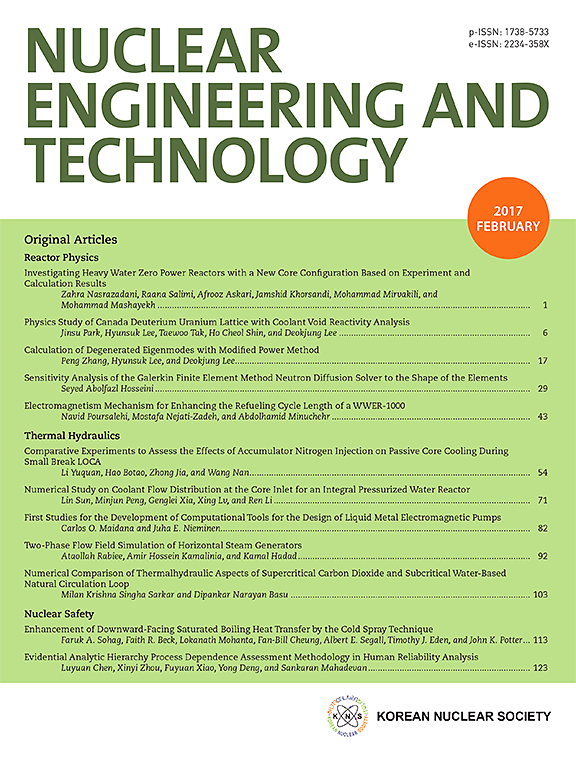Corrosive behavior of copper canisters under air and aerobic groundwater at early stages of deep geological disposal
IF 2.6
3区 工程技术
Q1 NUCLEAR SCIENCE & TECHNOLOGY
引用次数: 0
Abstract
Copper oxidation at low temperatures below 140 °C and its effects on corrosive behavior in aerobic groundwater are investigated to estimate the intactness of canisters at early stages of disposal. The Cu coupon surface is covered by fine particles that form thin oxide layers after 30 d of oxidation; a thin CuO layer of thickness <100 nm is formed after oxidation at 40 °C; after oxidation at 140 °C, the CuO surface changes to a CuO layer of thickness <500 nm. The thickness of the Cu surface oxidized at 90 °C is between those of the surfaces oxidized at 40 and 140 °C. All Cu coupons exhibit similar current densities ranging from 0.77 to 1.87 μA cm, although the corrosion potential of the Cu coupon layered with CuO is higher than that of the others. Long-term oxidation tests for 406 d reveal no significant changes in the Cu surface at temperatures below 90 °C, indicating no significant change in the electrochemical behavior. The results of this study suggest that the storage of canisters at temperatures below 90 °C has no significant effect on the degradation of canister performance in long-term disposal.深层地质弃置初期铜罐在空气和有氧地下水条件下的腐蚀行为
研究了铜在低于 140 °C 的低温下的氧化及其对好氧地下水中腐蚀行为的影响,以估计早期处置阶段滤毒罐的完好性。铜券表面被细颗粒覆盖,氧化 30 d 后形成薄氧化层;40 °C 氧化后形成厚度小于 100 nm 的薄 CuO 层;140 °C 氧化后,CuO 表面变为厚度小于 500 nm 的 CuO 层。在 90 °C 下氧化的铜表面厚度介于在 40 °C 和 140 °C 下氧化的表面厚度之间。所有的铜试样都显示出类似的电流密度,范围在 0.77 到 1.87 μA cm 之间,但层状 CuO 铜试样的腐蚀电位高于其他试样。406 d 的长期氧化测试显示,在低于 90 °C 的温度下,铜表面没有发生明显变化,这表明电化学行为没有发生重大变化。这项研究的结果表明,在低于 90 °C 的温度下储存滤毒罐对滤毒罐在长期处置过程中的性能退化没有明显影响。
本文章由计算机程序翻译,如有差异,请以英文原文为准。
求助全文
约1分钟内获得全文
求助全文
来源期刊

Nuclear Engineering and Technology
工程技术-核科学技术
CiteScore
4.80
自引率
7.40%
发文量
431
审稿时长
3.5 months
期刊介绍:
Nuclear Engineering and Technology (NET), an international journal of the Korean Nuclear Society (KNS), publishes peer-reviewed papers on original research, ideas and developments in all areas of the field of nuclear science and technology. NET bimonthly publishes original articles, reviews, and technical notes. The journal is listed in the Science Citation Index Expanded (SCIE) of Thomson Reuters.
NET covers all fields for peaceful utilization of nuclear energy and radiation as follows:
1) Reactor Physics
2) Thermal Hydraulics
3) Nuclear Safety
4) Nuclear I&C
5) Nuclear Physics, Fusion, and Laser Technology
6) Nuclear Fuel Cycle and Radioactive Waste Management
7) Nuclear Fuel and Reactor Materials
8) Radiation Application
9) Radiation Protection
10) Nuclear Structural Analysis and Plant Management & Maintenance
11) Nuclear Policy, Economics, and Human Resource Development
 求助内容:
求助内容: 应助结果提醒方式:
应助结果提醒方式:


